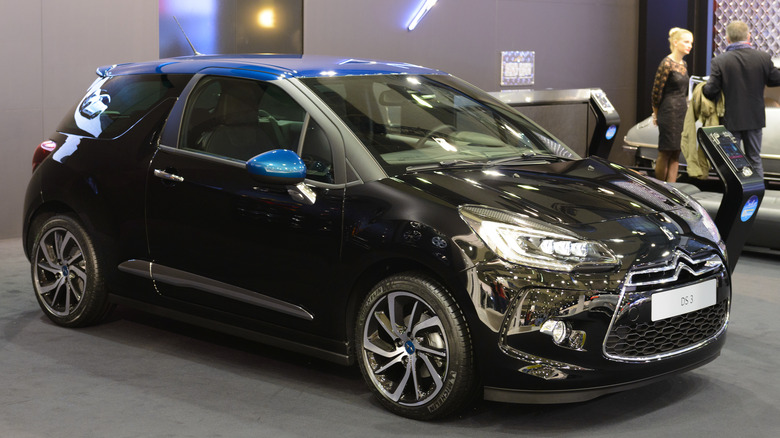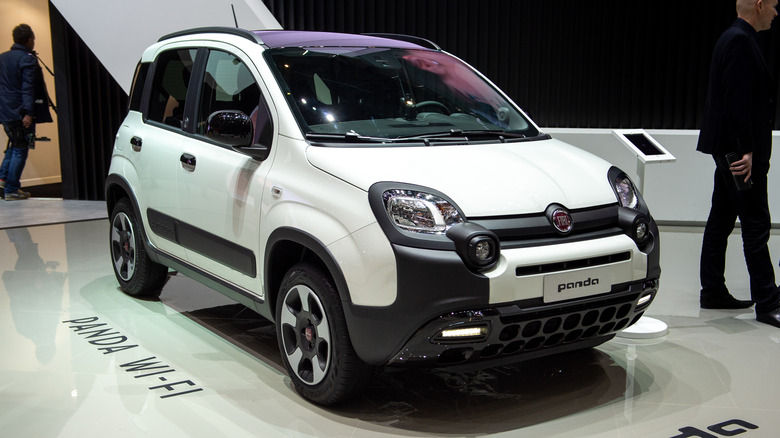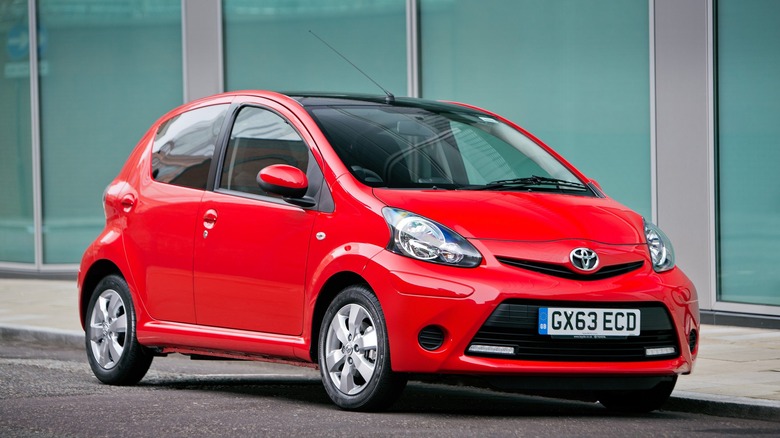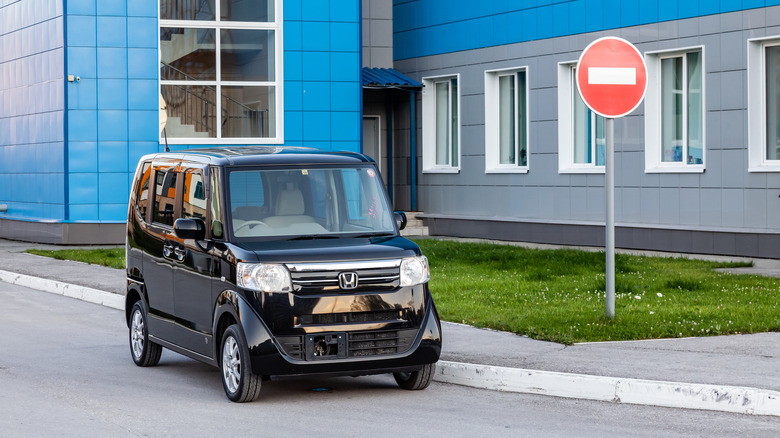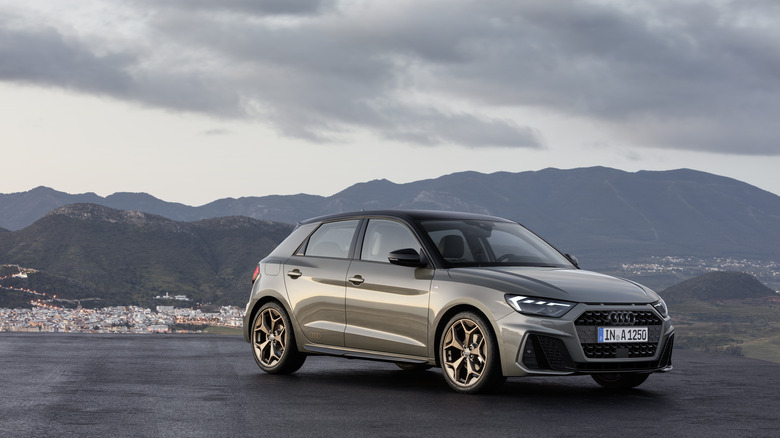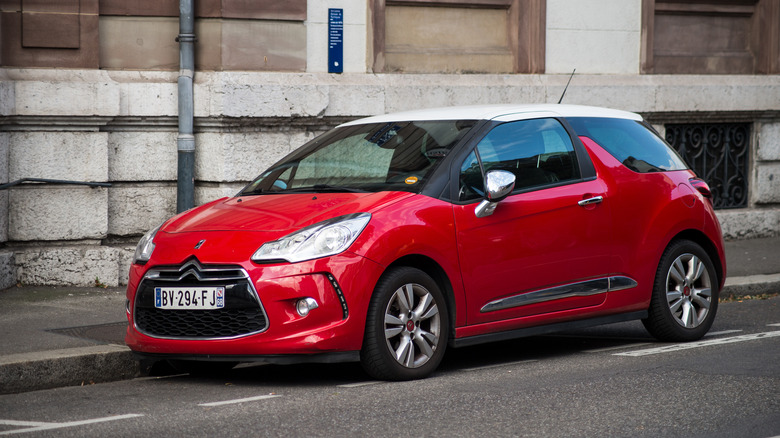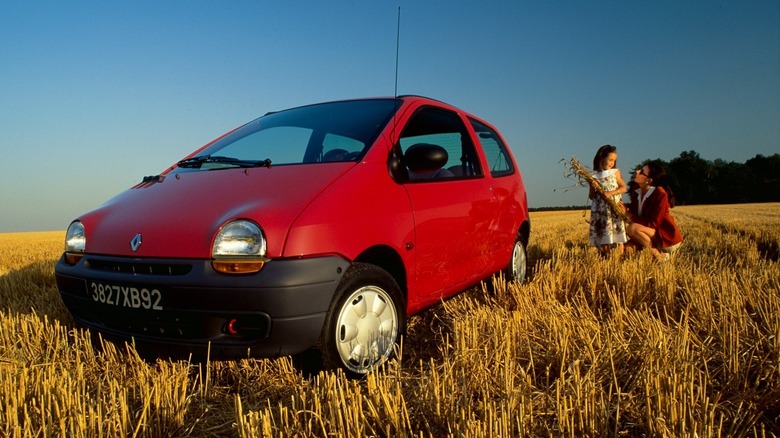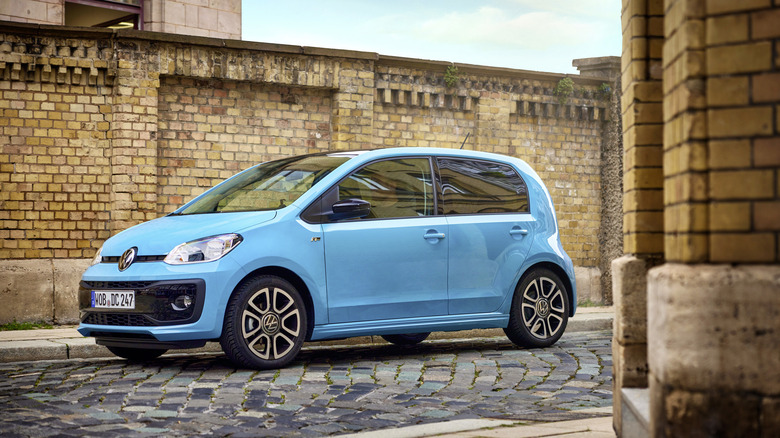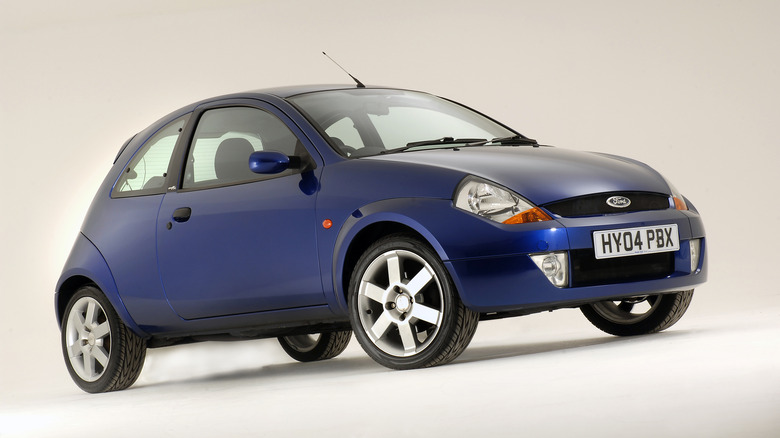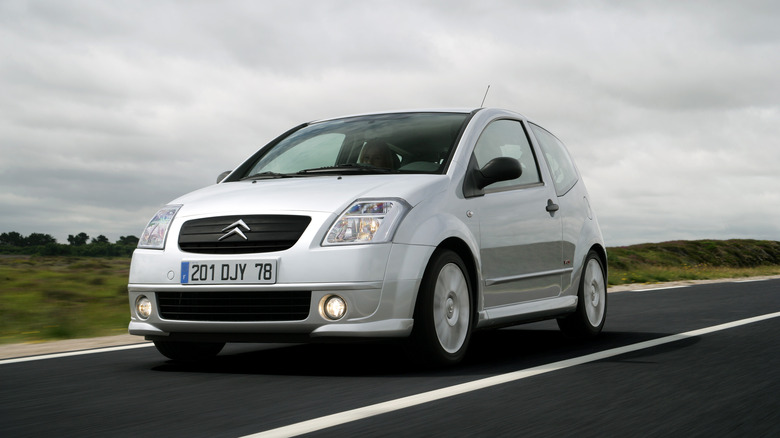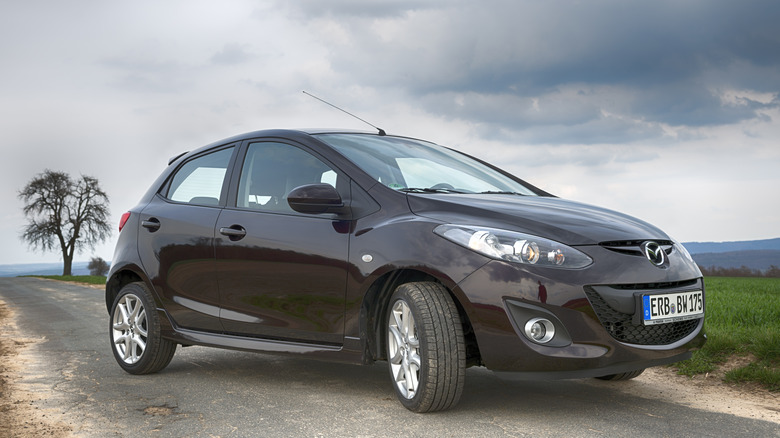10 Tiny But Brilliant Cars North America Never Got
Try as they might, automakers simply haven't been able to sell small cars to people in the United States, no matter how hard they push. The original Ford Fiesta, for example, was intended to be a world car, but it did so poorly in North America that it was immediately dropped after the first generation. American tastes and needs are vastly different from those of European and Japanese drivers, which is why the small, city-friendly car never really managed to strike a chord with American buyers.
As a result, European and Japanese automakers don't see a point in offering their smaller models to North American buyers, keeping them mostly for their local markets. It's a real shame, because that has meant North American buyers have missed out on some truly brilliant small cars. Maybe they were practical, represented creative ways to keep production costs down — and therefore keep prices down — or they were just good fun behind the wheel. Remember, a tiny car isn't necessarily a bad car — sometimes it's a fantastic one. Here are some of our favorites.
Fiat Panda
It's one of the best stories in the auto industry. The original Fiat Panda came along in 1980 to replace the Fiat 500 as the automaker's entry-level model. It was a small basic car that could do just about anything you asked from it, and that would also be dependable, reliable, and easy to work on. This would be one of Fiat's best decisions ever, as the original Panda carried on until 2003 with little to no changes.
Even in the car's next two generations, Fiat did not forget what made the original Panda so great. Even though Fiat does not have a stellar reputation for reliability, the Panda is a solid workhorse. With the optional AWD system in the 4x4 versions, it can get to places that other small cars wouldn't dare to even touch. Fiat has not given up on the Panda 4x4 either, continuing to offer it to this day.
The second generation Panda even brought along a fast version, the Panda 100HP, which pushed 100 horsepower as the name implies. The Panda is still such an enormous moneymaker for Fiat, in fact, that thanks to increased recent demand, it will not be fully replaced by the electric Panda that's due soon. That car is still happening, but the regular Panda will carry on for at least another three years badged as the Pandina. Despite the Panda's diminutive dimensions, its story and success are absolutely colossal.
Toyota Aygo
One of the most popular city cars in Europe during its heyday, the Toyota Aygo was a joint venture between the Japanese giant and the French PSA Group, owners of Peugeot and Citroen. The resulting family of triplets, the Aygo, the Peugeot 107, and the Citroen C1, took the city car to a whole other level. Cutesy styling concealed an interior that was very spacious by small car standards, as well as legendary Toyota dependability.
You could also get it with a whole lot of mod cons that people weren't really used to seeing in city cars at the time. Air conditioning was a popular option, but a proper navigation system was also available. The trio would go on to see a second generation, with much of the same core values retained, but more distinct styling between them. Unfortunately, the A-segment in Europe was a small footnote by the beginning of the 2020s.
Toyota isn't ready to give up though, as it now offers the Aygo X, previewed by the Aygo X prologue concept. The Aygo X is a tiny crossover with super affordable pricing and it looks surprisingly practical. The Aygo is a fantastic small car, and it's a shame that most other worldwide markets never got a chance to sample it.
Honda N-BOX
Even though kei cars never really reached the Western world, that hasn't stopped people in the West from obsessing over them. Kei trucks are a very recent obsession, and a lot of classic kei cars have actually stayed affordable. Kei cars can come in just about every shape and size. Their sole purpose is to maximize their capability within the size constraints of the kei class, and that is especially the case with the Honda N-BOX.
The N-BOX has been around since 2011, and it has since become one of Japan's bestselling cars — not just kei cars, mind you, but cars as a whole. It entered its third generation in 2023, retaining practically the same bonkers design. Despite its diminutive length of 133.7 inches, 99.2 of those are the wheelbase. This means more room inside, something aided further by the N-BOX's ridiculous height that is very close to that of a lot of humans.
This tiny kei minivan is also really popular with the disabled community, and Honda even offers a wheelchair accessibility ramp right from the factory. Thanks to the sliding doors, it's very easy to get in and out of. With its lineup of NA or turbo three-cylinder engines, it also has decent performance, and some pretty good features as well. We don't know what we need to do to convince Honda to offer the N-BOX globally, but we are willing to try.
Audi A1
For the longest time, the entry point into the Audi lineup was the A3. The Golf-based small hatchback was introduced in the late 90s, and it went on to write a success story of its own. However, seeing an opportunity with the growing segment of small stylish hatchbacks, of which the likes of the Mini and the Fiat 500 had already been dominating, Audi decided to give it a shot. After some reworking to the VW Polo platform, Audi's stylish small hatchback came out in 2010 in the form of the A1.
It was even smaller than the A3, and even though it was unmistakably an Audi, it was still more stylish and daring than just about anything the automaker was offering outside of the R8. The original A1 even offered the option of silver roof pillars, which bore a slight similarity to the R8's sideblades. The A1 was also offered with a lineup of small efficient VW Group engines, and there was even a hot S1 with a turbo four banger making 231 hp and AWD.
Even though this segment isn't nearly as big as it once was, Audi still offers the A1. It even offers a slightly raised, customizable A1 Citycarver version, which has small crossovers firmly in its sights. Although Audi has a reputation for very no-nonsense cars, the A1 is proof that the company's designers and engineers know how to let their hair down every once in a while.
Citroen DS3
In the late 2000s, Citroen decided to leverage one of its most storied nameplates, DS, for a group of more upmarket models. The lineup of new DS models kicked off with the small DS3. It was based on a familiar PSA Group platform, but it was much more stylish and trendy. Like some of the aforementioned, the DS3 also wanted a piece of the Mini and Fiat 500 pie, and it was quite successful in that mission.
One fun fact about the DS3 is that it shared part of its engine lineup with the contemporary Mini. The small diesel engines were the same as you might find in the Mini One D, and the Racing version of the DS3 featured the same 1.6-liter turbo four banger as the Mini Cooper S. Citroen was banking quite heavily on the fact that the DS3 wasn't retro, and the styling was one of the most loved aspects. The DS3 had its competitors licked when it came to interior space, and with being in this market segment, exterior customization options were mandatory.
Along with the regular hatchback, Citroen also offered a Cabrio version of the DS3 with a folding canvas roof. This was not only to sway Fiat 500C buyers, but it also improved on Citroen's less celebrated Pluriel. Sadly, this characterful small hatch could not stay afloat for too long, and it eventually died to make room for a crossover bearing the same name, now under Citroen's DS spinoff brand.
Renault Twingo
Renault had no idea it was about to launch a total small-car revolution back in the early 90s, but that's exactly what happened when the first generation Twingo officially went on sale in 1992. The idea was fairly simple: Make a car to replace the R4 that would be cheap to manufacture and buy, but also wouldn't feel prehistoric in just about every aspect. The Twingo stuck to these core pillars very well, which is why it was an enormous runaway success.
The initial run of Twingos featured a pushrod four-cylinder engine, and options included color-coded key interior pieces, a sunroof, and a fantastic palette of pleasing color schemes and incredibly 90s interior upholstery. Eventually, Renault would begin installing more modern powertrains and finessing the Twingo, but the first generation was such a success, that it carried on with very few changes until 2006.
While the second-generation cars were far more conventional, they still retained the Twingo's core pillars: basic, affordable, and incredibly competent transportation. This was also true of the most recent Twingo, despite the move to a rear-engine, RWD design thanks to sharing a bloodline with the Smart Forfour. Now, Renault is poised to bring back the original Twingo design as a super affordable EV, and it can't come soon enough.
Volkswagen Up
Spurred on by the success of the Toyota Aygo and similar vehicles, and after numerous different concepts, Volkswagen finally decided to join in on the ultra-affordable small car craze with the Up, or if we go by VW's silly suggested spelling, the "up!". Launched in 2011 alongside the almost identical Seat Mii and Skoda Citigo, the Up was built on a bespoke small car platform, and manufactured alongside the Porsche Cayenne and Volkswagen Touareg in Slovakia.
Moved along by a lineup of tiny, super-efficient three-cylinder engines, the Up also included some of the familiar cost-cutting measures we've seen on other cheap small cars, like pop-out rear windows and an all-glass tailgate. With it being a Volkswagen, however, it was a grown-up small car in a lot of ways. It was simple, very spacious inside for its size, and well-equipped for its price and class, with even the base models getting air-conditioning and an AUX port for the stereo. The more upscale ones offered stuff like parking sensors, cruise control, and heated seats.
Over the years, Volkswagen would expand the Up lineup extensively. There was a ruggedized Cross Up with a healthy supply of unpainted body cladding, the super fizzy Up GTI with a 115 hp turbocharged three-cylinder engine and a manual transmission, and there was also a fully electric version. The Up became one of the undisputed darlings of the segment, to the point that VW ended production only recently in November 2023.
Ford Ka
By the 1990s, Ford had already been doing the small car thing quite well, despite the Fiesta's flop in North America after multiple failed marketing pushes. With the Twingo kicking the ultra-affordable small car hype into high gear, Ford saw an opportunity for an even more affordable vehicle to slot below the Fiesta. The end result was the Ka, which like the Twingo, would go on to become a runaway success abroad.
Thanks to using a familiar platform from the Fiesta, and a proven, albeit antiquated powertrain initially, the Ka was cheap to manufacture and incredibly cheap to buy. The initial run of Kas didn't even have painted bumpers, and there were also no trim levels at first. Those might seem like befuddling decisions today, but a lot of that helped the Ka achieve success.
This is yet another small car that was so successful, the first generation lasted for a very, very long time. The Ka was still around even when Ford's Kinetic Design started to take hold, despite the Ka itself being styled with the automaker's New Edge design language. It also spawned the SportKa and StreetKa derivatives, both of which had more power, sportier styling, and a folding soft top in the case of the StreetKa. The second generation car was based on the Fiat 500, and it also did quite well, but the third generation would sadly spell the end of this great little car as we know it.
Citroen C2
It's a common belief that the French are quite good at making small cars. The reason why that belief is common is because it tends to be true. Shortly after Citroen launched its best-selling C3 subcompact, it decided to spin off another model on the same platform aimed at young, trendy buyers. The C2 was a little smaller, and a lot more stylish.
Along with its lineup of tiny efficient engines, the C2 was also the only way you could have a small hot hatchback from the French automaker in the 2000s. The C2 VTS replaced the storied Saxo VTS, and with 116 hp, it was pretty brisk, although maybe not quite as fast as its competitors. The C2 was also fairly spacious on the inside, and it offered some pretty hilarious transparent trim options for the interior. You could even get it with a semi-automatic transmission, even though it wasn't very good.
Despite its many good qualities, Citroen ultimately wanted to put as many of its customers as possible into the even smaller C1 and the much more popular C3. And so, the C2 was canned in 2009 after only six years, with no direct replacement. The C2 is not very fondly remembered by most, but it stands today as a massively underrated small car with a lot going for it.
Mazda 2
Also known as the Mazda Demio in the Japanese domestic market, the Mazda 2 was the Japanese automaker's answer to cars like the Ford Fiesta and Volkswagen Polo. This one is cheating slightly, as the Mazda 2 would eventually reach North America as the Toyota Yaris/Scion iA. The second-generation car sold from 2007 to 2015, and didn't make the cut, however. It's easy to understand why, but one look at the Mazda 2 makes it clear what Americans missed out on.
The second-generation Mazda 2 was one of only a couple of B-segment cars offering a driving experience that induced smiles and giggles. That shouldn't come as a surprise, given all of Mazda's seriously fast sports cars and, you know, the Miata. The Mazda 2, like most of the automaker's lineup, also captured some of the essence of the Miata, with a responsive drivetrain and a shifter that felt like it was pulled right from the two-seat legend.
When you needed it, the Mazda 2 took off its clown shoes and put on a pair of perfectly ordinary sneakers. It was practical, spacious, well-equipped, and really cheap in just about every market. While not as successful as its European contemporaries, it offered a fantastic alternative for those looking for a bit more fizz out of their subcompact car.
